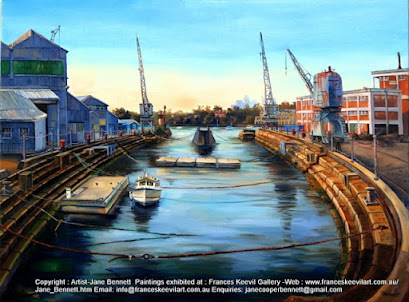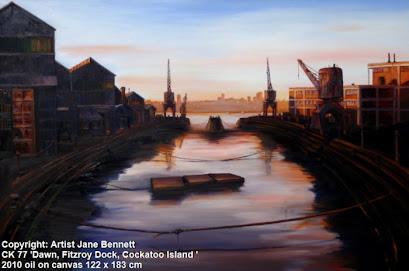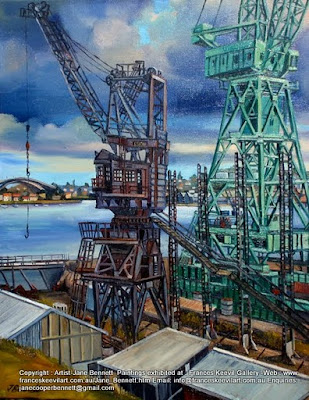Cockatoo Island - A lost World
Cockatoo Island has had a strange history- a former 19th century prison, then a Naval dockyard and then after being abandoned and desolate for over a decade it has been reinvented as a performance, art and music venue.
The Island is filled with evocative relics of Sydney's history, from the convict-built sandstone ruins to the gritty grandeur of industrial architecture.
The Island is filled with evocative relics of Sydney's history, from the convict-built sandstone ruins to the gritty grandeur of industrial architecture.
 |
"Cockatoo Island convict ruins"
2007 oil painting on canvas 15 x 21cm |
Now half the sheds and cranes (unfortunately including Titan) have gone, and Cockatoo Island has been reincarnated as a festival venue for comedy, art and music.
When it was likely that the island would cease shipbuilding when the lease finally ran out in 1992, the workforce on the island staged a wildcat strike during 1989.
After a great deal of tension the island closed for ship-building forever in 1991 and many cranes and buildings were demolished. It became a "Ghost town" for over a decade.
In 2005 I was asked by The Sydney Harbour Federation Trust to record the island before they refurbished it for the tourists.
In 2005 I was asked by The Sydney Harbour Federation Trust to record the island before they refurbished it for the tourists.
Fitzroy Dock
Fitzroy was a dry dock for Royal Naval vessels in the South Pacific.
 |
| 'Fitzroy Dock, early morning' 2007 oil on canvas 75 x 100cm |
Thousands of tons of sandstone were quarried by convicts working in leg irons. Admiralty designed the original plan, but Captain Gother Mann expanded its size, used electronically detonated explosives to remove the cliff face, assembled the pumping machinery and designed the floating caisson (gate).
In 1857 the dock was 284 feet long, and was extended in 1870 and then in 1880 to 475 feet.
Fitzroy dock wasn't big enough for the new steel battleships, so ₤150,000 was allocated for construction of a graving dock intended to be the largest in the southern hemisphere – Sutherland Dock.
Recently I sold a painting of Fitzroy Dock to the man who had opened the caissons for the final time and let the water into Fitzroy and Sutherland Docks, the act that signalled the island's demise as a part of Sydney's Working Harbour!
Recently I sold a painting of Fitzroy Dock to the man who had opened the caissons for the final time and let the water into Fitzroy and Sutherland Docks, the act that signalled the island's demise as a part of Sydney's Working Harbour!
 |
Dawn Fitzroy Dock
2010 oil on canvas 122 x 183cm
|
This is painted looking east to catch the first rays of light just beginning to reveal the form of the cranes.
The
object in the middle of the dock is a floating caisson. The present
floating caisson was made in 1927 but is a replica of the 1857
original. This gate is pulled into and out of place with a tugboat and
its position is predetermined by the “fit”. The “fit” consisted of
2 grooves, one of which has been cut into each side of the dock,
running vertically down to the floor of the dry dock where they join a
gutter cut across the dock entrance. When the caisson was in position
the workmen would open a flood valve to let water in to sink it into
position, sealing the dock.
The
two cranes in the background, standing guard on either side of Fitzroy
Dock are Utility cranes built in 1918, but the other cranes are even
older, On the right hand side is the rounded shape of a Priestman Crane,
built in 1893. On the other side, hidden in shadow, is a green crane
built in 1857, and known affectionately as the 'African Queen'. | ||
|
|
Built from 1882-1890, Sutherland Dock was designed by Louis Samuel, a brilliant 23 year old engineer, whose company also obtained the contract to build the piers for the Hawkesbury River Bridge.
The Turbine hall is on the right, in the centre stands an old (1893) Priestman steam crane and on the left is the chimney of the power station.
 | ||
This 1918 utility crane once had a pale green companion crane, seen in the 1989 painting below.
This painting shows the handsome Military Officers' Headquarters, a relic of the Island's convict heritage, in the background.
 |
Compare this 1989 painting with the 2007 one that I deliberately painted at the same location, at the same time of day, at the same time of year and on the same format canvas 18 years apart.
 |
| CK52'Crane from the Officers headquarters' 2007 oil on canvas 61 x 46cm Enquiries |
The green crane is the most obvious omission- a casualty of a storm not long after this was painted.
Other changes are subtler: a touch of rust here and there, the "Paint shop" building replaced by toilet blocks for the tourists, missing structures from the slipway and new developments in Hunters Hill on the horizon.
 |
'Utility Crane study 1' 2007 oil on canvas 18 x 13cm
PRIVATE COLLECTION : SYDNEY
|
 |
Amongst its heroic exploits was its role in the building of the Sydney Harbour Bridge during 1931-2.
One of her last projects was unloading the historic train 'The Flying Scotsman' at the (now demolished) Pyrmont Wharves and Goods Yard. I witnessed this and did some paintings from my vantage point on the roof of the Pyrmont Power Station (also now demolished).
It was sold at the 1992 auction of many heritage items, and sank on its way to Singapore in mysterious and suspicious circumstances. She was finally scuttled off Camden Head (near Port Macquarie).
Read more about the tragic end of this iconic piece of Australian maritime heritage :
'Death of a Titan' 'Afloat' magazine February 2011 by Alan Lucas
The Tunnels
Cockatoo Island's peculiar history and geography has led to it being honey-combed with tunnels.
One of her last projects was unloading the historic train 'The Flying Scotsman' at the (now demolished) Pyrmont Wharves and Goods Yard. I witnessed this and did some paintings from my vantage point on the roof of the Pyrmont Power Station (also now demolished).
It was sold at the 1992 auction of many heritage items, and sank on its way to Singapore in mysterious and suspicious circumstances. She was finally scuttled off Camden Head (near Port Macquarie).
Read more about the tragic end of this iconic piece of Australian maritime heritage :
'Death of a Titan' 'Afloat' magazine February 2011 by Alan Lucas
The Tunnels
Cockatoo Island's peculiar history and geography has led to it being honey-combed with tunnels.
There are 6 tunnels cut through the sandstone escarpment on the lower level of the Island.
The narrow 'Dog Leg' tunnel, so-called because of its crookedness, is on the eastern side of the Island. It has a passageway to the west of it which travels parallel to its path halfway along its length.
There is a small disused tunnel near the entrance to the giant Turbine Hall.
There is a small disused tunnel near the entrance to the giant Turbine Hall.
The largest tunnel is a straight road, neatly bisecting the island from east to west, and large and high enough for vehicular access.
Next to it is a smaller ante- chamber which doesn't travel the full length through to the other side.
Finally there is a small passageway cut through the western end which leads to the former power station.
 |
'Cockatoo Island Tunnel' 2007 oil painting on tondo (circular canvas) 31cm diameter Enquiries |
This circular painting or 'tondo' shows the largest central tunnel from the southern side of the Island, looking north towards Hunter's Hill.
I started painting on Cockatoo Island in the mid 1980s when it was still operational. I would catch one of the old "K" ferries such as the 1912 'Kanangra' which is now being restored by the Sydney Heritage Fleet at their shipyard in Rozelle, from Circular Quay or the Valentia Street (Woolwich) wharf.
I used to leave my easel, paints and table in the office of the Ship Painters and Dockers building between Fitzroy and Sutherland docks.
I started painting on Cockatoo Island in the mid 1980s when it was still operational. I would catch one of the old "K" ferries such as the 1912 'Kanangra' which is now being restored by the Sydney Heritage Fleet at their shipyard in Rozelle, from Circular Quay or the Valentia Street (Woolwich) wharf.
I used to leave my easel, paints and table in the office of the Ship Painters and Dockers building between Fitzroy and Sutherland docks.
There was a sign "Pro Painter Foreman" on the door, which always made me laugh. I was so naive that I didn't know anything about the reputation of this notorious union!
View article about my solo exhibition "Lost Worlds" by Steve Meacham in Sydney Morning Herald
View article about my solo exhibition "Lost Worlds" by Steve Meacham in Sydney Morning Herald





No comments:
Post a Comment